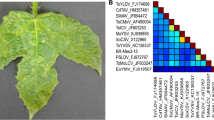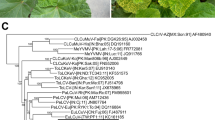Abstract
Rhynchosia minima (L.) DC. (Fabaceae) plants exhibiting bright golden mosaic symptoms were previously associated with begomovirus infection in Yucatan, México [1]. To characterize the begomovirus infecting these plants, the complete bipartite genome was cloned and sequenced. Sequence comparisons indicated that the virus was distinct from all other begomoviruses known to date, including those previously identified from symptomatic R. minima, and the name Rhynchosia yellow mosaic Yucatan virus (RhYMYuV) is proposed. Pairwise comparisons indicated that RhYMYuV DNA-A [2,597 nt, (EU021216)] and DNA-B [2,542 nt, (FJ792608)] components shared the highest nt sequence identity with Cabbage leaf curl virus (CaLCuV), 87% for component A and 71% for component B. Phylogenetic analysis indicated that both components of RhYMYuV are most closely related to other New World begomoviruses, having as closest relatives immediate outliers to the major Squash leaf curl virus (SLCV) clade. Recombination analysis of the RhYMYuV genome indicated that the DNA-A component has arisen through intermolecular recombination. R. minima plants inoculated with the monomeric clones developed a bright yellow mosaic similar to symptoms observed in naturally infected plants, confirming that the clones were infectious. Nicotiana benthamiana plants biolistically inoculated with monomeric clones developed curling and chlorosis in the newly emerging leaves. RhYMYuV was also detected in symptomatic Desmodium sect. Scorpiurus Benth. (Fabaceae) that were collected near the RhYMYuV-infected plants.



Similar content being viewed by others
References
Hernández-Zepeda C, Idris AM, Carnevali G, Brown JK, Moreno-Valenzuela OA (2007) Preliminary identification and coat protein gene phylogenetic relationships of begomoviruses associated with native flora and cultivated plants from the Yucatan Peninsula of Mexico. Virus Genes 35:825–833
Lazarowitz SG, Wu LC, Rogers SG, Elmer JS (1992) Sequence-specific interaction with the viral AL1 protein identifies a geminivirus DNA replication origin. Plant Cell 4:799–809
Brown JK (2001) The molecular epidemiology of Begomoviruses. In: Khan JA, Dykstra J (eds) Trends in plant virology. The Haworth Press, Inc, NY, pp 279–316
Mansoor S (2003) Geminivirus disease complexes: an emerging threat. Trends in Plant Sci 8:128–134
Moffat AS (1999) Geminivirus emerge as serious crop threat. Science 286:1835
Argüello-Astorga GR, Guevara-González RG, Herrera-Estrella LR, Rivera-Bustamante RF (1994) Geminivirus replication origins have a group-specific organization of iterative elements: a model for replication. Virology 203:90–100
Godínez-Hernández Y, Anaya-López JL, Díaz-Plaza R, González-Chavira M, Rivera-Bustamante RF, Torres-Pachecho I, Guevara-González RG (2001) Characterization of resistance to Pepper huasteco geminivirus in chili peppers (Capsicum chinense) from Yucatán, México. HortScience 36:139–142
Garrido-Ramírez ER, Gilbertson RL (1998) First report of Tomato mottle geminivirus infecting tomatoes in Yucatan, Mexico. Plant Dis 82:592
Ascencio-Ibáñez JT, Díaz-Plaza R, Méndez-Lozano J, Monsalve-Fonnegra ZI, Arguello-Astorga GR, Rivera-Bustamante RF (1999) First report of Tomato yellow leaf curl geminivirus in Yucatán, México. Plant Dis 83:1178
Carnevali G, Ramírez-Morillo I, González-Iturbe JA (2003) Flora y vegetación de la Península de Yucatán. In: Colunga García-Marín P, Larqué Saavedra A (eds) Naturaleza y Sociedad del Área Maya: pasado, presente y futuro. Centro de Investigación Científica de Yucatán, A. C. Mérida. USDA, ARS, National Genetic Resources Program, pp 53–68
Kashina BD, Mabagla RB, Mpunami AA (2002) Reservoir weed hosts of tomato yellow leaf curl begomovirus from Tanzania. Archiv Phytopath Pflanz 35:269–278
García-Andrésa S, Monci F, Navas-Castillo J, Moriones E (2006) Begomovirus genetic diversity in the native plant reservoir Solanum nigrum: evidence for the presence of a new virus species of recombinant nature. Virology 350:433–442
Roye ME, McLaughlin WA, Nakhla MK, Maxwell DP (1997) Genetic Diversity Among Geminiviruses Associated with the Weed Species Sida spp., Macroptilium lathyroides, and Wissadula amplissima from Jamaica. Plant Dis 81:1251–1258
Brown JK, Idris AM, Torres-Jerez I, Banks GK, Wyatt SD (2001) The core region of the coat protein gene is highly useful for establishing the provisional identification and classification of begomoviruses. Arch Virol 146:1–18
Idris AM, Bird J, Rogan DM, Brown JK (2002) Molecular characterization of Rhynchosia mosaic virus-Puerto Rico associated with symptomatic Rhynchosia minima and Cajanus cajan in Puerto Rico. Plant Dis 86:558
Potter JL, Roca de Doyle MM, Nakhla MK, Maxwell DP (2000) First report and characterization of Rhynchosia golden mosaic virus in Honduras. Plant Dis 84:1045
Ilyas M, Qazi J, Mansoor S, Briddon RW (2009) Molecular characterisation and infectivity of a “Legumovirus” (genus Begomovirus: family Geminiviridae) infecting the leguminous weed Rhynchosia minima in Pakistan. Virus Res 145:279–284
Haible D, Kober S, Jeske H (2006) Rolling circle amplification revolutionizes diagnosis and genomics of geminivirus. J Virol Methods 135:9–16
Sambrook J, Fritsch EF, Maniatis T (1989) Molecular cloning: a laboratory manual. Cold Spring Harbor Laboratory Press, Cold Spring Harbor
Idris AM, Brown JK (1998) Sinaloa tomato leaf curl geminivirus: biological and molecular evidence for a new subgroup III Virus. Phytopathology 88:648–657
Carrillo-Tripp J, Lozoya-Gloria E, Rivera-Bustamante RF (2007) Symptom remission and specific resistance of pepper plants after infection by PepGMV. Phytopathology 97:51–59
Ascencio-Ibañez JT, Settlage SB (2007) DNA abrasion onto plants is an effective method for geminivirus infection and virus-induced gene silencing. J Virol Met 142:198–203
Martin D, Rybicki E (2000) RDP: detection of recombination amongst aligned sequences. Bioinformatics 16:562–563
Padidam M, Sawyer S, Fauquet CM (1999) Possible emergence of new geminiviruses by frequent recombination. Virology 265:218–225
Martin DP, Posada D, Crandall KA, Williamson C (2005) A modified bootscan algorithm for automated identification of recombinant sequences and recombination breakpoints. AIDS Res Hum Retroviruses 21:98–102
Smith J (1992) Analyzing the mosaic structure of genes. J Mol Evol 34:126–129
Posada D, Crandall KA (2001) Evaluation of methods for detecting recombination from DNA sequences: computer simulations. Proc Natl Acad Sci 98:13757–13762
Gibbs MJ, Armstrong JS, Gibbs AJ (2000) Sister-Scanning: a Monte Carlo procedure for assessing signals in recombinant sequences. Bioinformatics 16:573–582
Martin DP, Williamson C, Posada D (2005) RDP2: recombination detection and analysis from sequence alignments. Bioinformatics 21:260–262
Fauquet CM, Briddon RW, Brown JK, Moriones E, Stanley J, Zerbini M, Zhou X (2008) Geminivirus strain demarcation and nomenclature. Arch Virol 153:783–821
Chatterji A, Chatterji U, Beachy R, Fauquet C (2000) Sequence parameters that determine specificity of binding of the replication-associated protein to its cognate site in two strains of Tomato leaf curl virus—New Delhi. Virology 273:341–350
Orozco BM, Gladfelter HJ, Settlage SB, Eagle PA, Gentry RN, Hanley-Bowdoin L (1998) Multiple cis elements contribute to geminivirus origin function. Virology 242:346–356
Chakraborty S, Vanitharani R, Chattopadhyay B, Fauquet CM (2008) Supervirulent pseudorecombination and asymmetric synergism between genomic components of two distinct species of begomovirus associated with severe tomato leaf curl disease in India. J Gen Virol 89:818–828
Brown JK, Idris AM, Ostrow KM, Goldberg N, French R, Stenger DC (2005) Genetic and phenotypic variation of the pepper golden mosaic virus complex phytopathology 95:1217–1224
Brown JK, Idris AM, Alteri C, Stenger DC (2002) Cucurbit leaf curl virus, a new emergent begomovirus species able to form viable reassortants with related viruses in the squash leaf curl virus cluster. Phytopathology 92:734–742
Idris AM, Mills-Lujan K, Baumann K, Brown JK (2008) Melon chlorotic leaf curl virus: characterization and differential reassortment with closest relatives reveals adaptive virulence in the SLCV clade, and host shifting by the host-restricted BCaMV. J Virol 82:1959–1967
Garcia-Arenal F, Fraile A, Malpica JM (2001) Variability and genetic structure of plant virus populations. Annu Rev Phytopathol 39:157–186
Fiallo-Olive E, Rivera-Bustamante RF, Martinez-Zubiaur Y (2009) Tobacco yellow crinkle virus, a new bipartite begomovirus infecting tobacco and pepper in Cuba. New Disease Reports, vol 19, February–August 2009
Bird J (1962) A whitefly-transmitted mosaic of Rhynchosia minima and its relation to tobacco leaf curl and other virus diseases of plants in Puerto Rico. Phytopathology 52:286
Ascencio-Ibañez JT, Arguello-Astorga GR, Méndez-Lozano J, Rivera-Bustamante RF (2002) First report of Rhynchosia golden mosaic virus (RhGMV) infecting tobacco in Chiapas, Mexico. Plant Dis 86:692
Méndez-Lozano L, Perea-Araujo L, Ruelas-Ayala RD, Leyva-López NE, Mauricio-Castillo JA, Argüello-Astorga GR (2006) A begomovirus isolated from chlorotic and stunted soybean plants in Mexico is a new strain of Rhynchosia golden mosaic virus. Plant Dis 90:972
Acknowledgments
Cecilia Hernández-Zepeda acknowledges postdoctoral fellowship support from Consejo Nacional de Ciencia y Tecnología (Conacyt, México) and Cinvestav. This research was partially supported by a Conacyt grant to RFRB. We thank Salvador Ambriz-Granados for his technical assistance.
Author information
Authors and Affiliations
Corresponding author
Rights and permissions
About this article
Cite this article
Hernández-Zepeda, C., Brown, J.K., Moreno-Valenzuela, O.A. et al. Characterization of Rhynchosia yellow mosaic Yucatan virus, a new recombinant begomovirus associated with two fabaceous weeds in Yucatan, Mexico. Arch Virol 155, 1571–1579 (2010). https://doi.org/10.1007/s00705-010-0730-0
Received:
Accepted:
Published:
Issue Date:
DOI: https://doi.org/10.1007/s00705-010-0730-0




